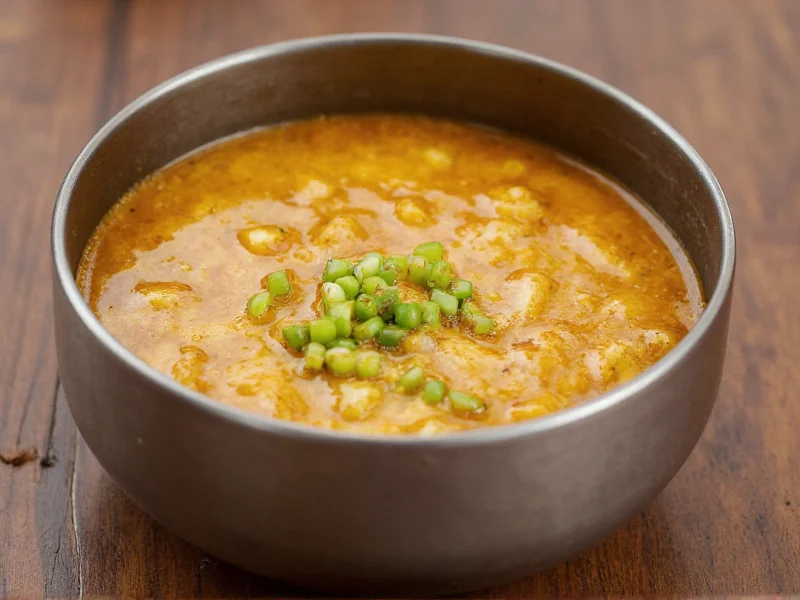Unlike standard garlic soups that use raw or quickly cooked garlic, golden garlic soup requires patience and precision. The "golden" transformation occurs when garlic reaches approximately 300°F (149°C), triggering the Maillard reaction that develops complex flavors while preserving health-promoting properties. This technique has roots in Mediterranean and French culinary traditions, where slow-cooked garlic features prominently in dishes like aioli and soup au pistou.
The Science Behind the Golden Transformation
Garlic's transformation from pungent to golden sweet isn't merely visual—it represents significant chemical changes. Raw garlic contains alliin, an odorless compound that converts to allicin when crushed. When heated slowly to golden perfection (not beyond 356°F/180°C), allicin transforms into beneficial sulfur compounds like diallyl disulfide and ajoene, which research suggests offer cardiovascular and anti-inflammatory benefits.
Exceeding the ideal temperature range causes bitter compounds to form, while insufficient cooking leaves harsh, unbalanced flavors. The precise window for optimal golden garlic occurs between 12-18 minutes of gentle cooking in olive oil at medium-low heat, depending on garlic variety and quantity.
| Cooking Stage | Temperature Range | Flavor Profile | Key Compounds |
|---|---|---|---|
| Raw | Room temperature | Sharp, pungent | Alliin, Allicin |
| Golden | 284-356°F (140-180°C) | Sweet, nutty, complex | Diallyl disulfide, Ajoene |
| Burnt | Above 374°F (190°C) | Bitter, acrid | Pyrazines, Acrylamide |
Traditional Preparation Methods
Culinary traditions worldwide have developed distinct approaches to achieving perfect golden garlic soup. French soupe à l'ail typically uses stale bread and thyme, while Spanish sopa de ajo incorporates paprika and sherry vinegar. The common thread is the careful attention to garlic's transformation stage.
Professional chefs emphasize these critical techniques for authentic golden garlic soup:
- Garlic selection: Use fresh, firm bulbs with tight skins—avoid sprouted or soft cloves
- Cutting technique: Leave cloves mostly whole with just the tip removed to prevent burning
- Oil temperature: Heat olive oil to shimmering point (about 275°F/135°C) before adding garlic
- Patience: Stir occasionally but allow 12-18 minutes for gradual color development
- Acid balance: Add lemon juice or vinegar at the end to brighten the rich flavors
Perfect Golden Garlic Soup Recipe
This refined recipe yields four servings of authentic golden garlic soup with balanced flavors and optimal nutritional benefits. The method focuses on precise temperature control to achieve that signature golden hue without bitterness.
Ingredients
- 18 large garlic cloves, unpeeled
- 3 tablespoons extra-virgin olive oil
- 4 cups low-sodium vegetable broth
- 1 medium yellow onion, finely diced
- 1 teaspoon fresh thyme leaves
- ½ teaspoon smoked paprika (optional)
- 2 slices rustic bread, toasted
- 1 tablespoon lemon juice
- Salt and freshly ground black pepper to taste
Step-by-Step Preparation
- Prepare garlic: Trim only the very tips of unpeeled garlic cloves. This protects them during cooking while allowing flavors to infuse.
- Slow roast: Heat olive oil in heavy-bottomed pot over medium-low heat. Add garlic and onion, stirring occasionally until garlic turns golden (12-18 minutes). Do not rush—this is the critical flavor development stage.
- Build base: Add vegetable broth, thyme, and paprika. Bring to gentle simmer (do not boil) and cook uncovered for 20 minutes.
- Blend carefully: Remove from heat. Squeeze roasted garlic from skins into broth. Using an immersion blender, puree until smooth. Alternatively, carefully transfer to countertop blender in batches.
- Final touches: Return to low heat. Stir in lemon juice, salt, and pepper. Simmer 5 minutes more to meld flavors.
- Serve: Ladle into bowls with toasted bread slice. Drizzle with additional olive oil if desired.
Avoiding Common Preparation Mistakes
Even experienced cooks can encounter pitfalls when preparing golden garlic soup. Understanding these common errors ensures consistent results:
- Overheating oil: Starting with oil that's too hot causes immediate browning rather than gradual golden transformation. Test oil readiness by adding one garlic clove—it should sizzle gently, not violently.
- Peeling before cooking: Unpeeled garlic cloves protect against burning while allowing flavors to develop. Peeling beforehand increases burning risk.
- Insufficient cooking time: Rushing the process yields sharp, raw garlic flavors rather than the desired sweet complexity.
- Over-blending: Blending hot soup creates steam pressure that can cause dangerous splatters. Always cool slightly and leave vent space in blender.
- Adding dairy too early: If incorporating cream or cheese, add only after removing from heat to prevent curdling.
Nutritional Profile and Health Considerations
Golden garlic soup offers notable nutritional advantages over standard garlic preparations. The gentle cooking process preserves more beneficial compounds than boiling while reducing the harshness that can cause digestive discomfort.
Per serving (1 cup), this soup typically contains:
- Approximately 90-120 calories
- 6-8g healthy fats (primarily from olive oil)
- 8-10g carbohydrates
- 2-3g dietary fiber
- Significant allicin-derived compounds with potential cardiovascular benefits
While generally well-tolerated, those with sensitive digestive systems should start with smaller portions. The soup is naturally vegan and gluten-free when using appropriate broth, making it suitable for various dietary needs.
Serving Variations and Pairings
Golden garlic soup's versatility allows for numerous adaptations to suit different occasions and preferences:
- Classic presentation: Serve hot with crusty bread and a drizzle of high-quality olive oil
- Summer variation: Chill completely and serve cold with cucumber ribbons for a refreshing twist
- Protein enhancement: Top with poached egg or white beans for added protein
- Creamy version: Blend in ¼ cup coconut milk for richness without dairy
- Wine pairing: Complements dry white wines like Sauvignon Blanc or unoaked Chardonnay
For optimal flavor development, prepare the soup one day ahead—reheating actually improves the flavor integration. Store in airtight container in refrigerator for up to 4 days or freeze for up to 3 months.











 浙公网安备
33010002000092号
浙公网安备
33010002000092号 浙B2-20120091-4
浙B2-20120091-4